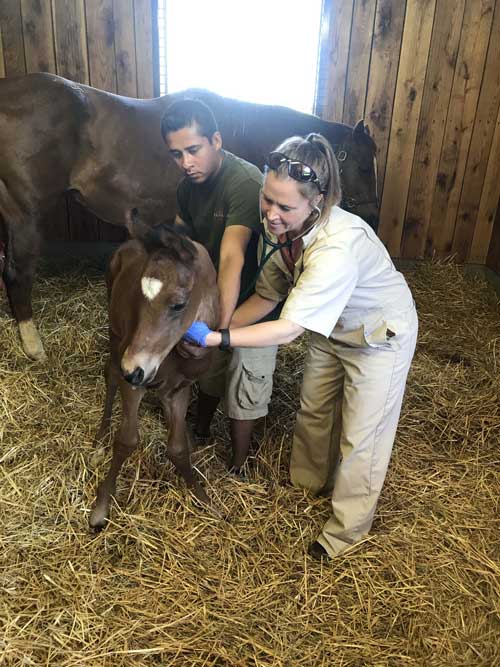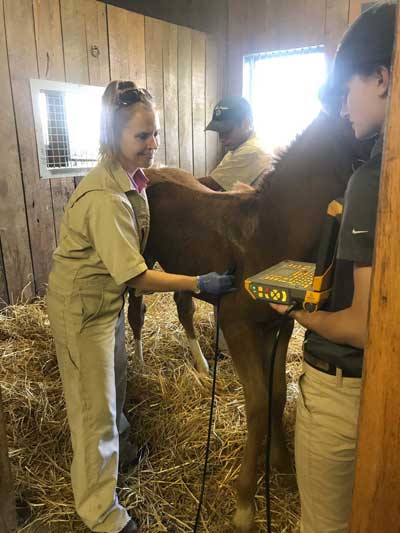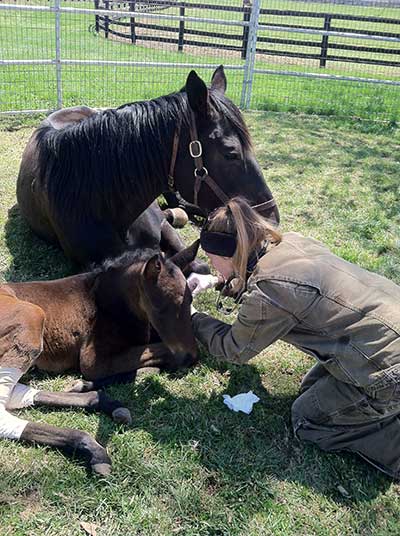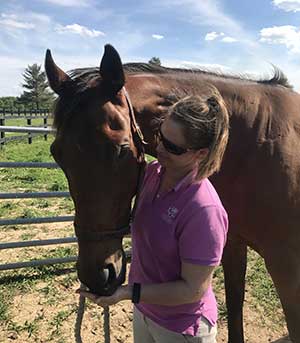
Please define Neonatal Care for Foals? Do all foals require neonatal care? What are the main cases in which neonatal care is advised?
Merriam-Webster.com defines NEONATE as : a newborn child or mammal. The “Neonatal Period” is the time when the newborn undergoes a physiological adjustment from the uterine environment to extrauterine life. In humans this is considered from birth to one month, however in the more precocious equine, we generally consider this to be the first 7 days of postnatal life.
Therefore when considering “neonatal care” we are referring to the routine preventative care and initial assessment of the newborn foal within the first 24 hours of life as well as any further follow up and treatment warranted based on physical exam and basic bloodwork.
All foals should be examined by a veterinary professional as there are many problems that begin with very subtle discrepancies that an owner may not become aware of until disease is advanced. Neonatal foals can deteriorate rapidly, so early detection and treatment is essential for the best outcome.
Neonatal care may be required sooner and be more extensive for higher risk foals such as those associated with dystocia (obstructed labor), premature placental separation (red bag), placentitis, prematurity, meconium staining (fetal diarrhea), failure of passive transfer, and those foals who have not stood and nursed by 3-4 hours of age.
“Neonatal Maladjustment Syndrome” (“Dummy Foal Syndrome”) is becoming an increasing problem seen in the equine breeding industry; What is “Neonatal Maladjustment Syndrome” and what causes it? Is it preventable, and how is it treated?
Neonatal Maladjustment Syndrome (“Dummy Foal Syndrome”) is not necessarily a disease per se but a syndrome used to describe newborn foals that exhibit behavioral and/or neurologic abnormalities resulting from a hypoxic insult (inadequate oxygen supply).
Clinical presentation varies widely, but signs can be mild, including loss of affinity for mare, poor suckle reflex, chewing/facial spasms, hypersensitivity to touch, abnormal respiratory patterns, depression and sleepiness. More severe signs include inability to stand, central blindness, stupor and seizures.
Signs are a result of oxygen debt to the brain - these signs may be evident at birth, but may not be observed until foal is 24-48 hours old.
Neonatal Maladjustment Syndrome (NMS) is more obviously associated with an adverse event at time of foaling, such as a dystocia or premature placental separation (“red bag” foaling), but is also observed in many foals that have not had an obvious periparturient (around the time of foaling) issue.
There is frequently an unrecognized in utero hypoxia which makes these cases less obvious. Hypoxia can occur secondary to a decreased blood flow to the placenta during pregnancy because of placentitis (inflammation of the placenta) or an issue with the dam’s health.
It can also occur shortly after birth, usually resulting from a primary issue with the foal’s health including sepsis (infection), pulmonary (lung) disease or problems associated with prematurity. Although frustrating, often a clear cause goes unidentified.

Treatment of NMS foals is largely supportive and will depend on how severely the foal is affected. Many will require extensive nursing care, some of which can be performed at the farm, but more extensive critical care may require referral to a clinic for continuous monitoring.
Most are placed on antibiotics, as they are compromised and prone to infection. In addition, most will receive anti-inflammatories to reduce swelling in the brain, and anti-oxidants (thiamine and Vitamin C) thought to protect cells in the brain and promote healing.
Some foals will get intranasal oxygen and intravenous fluids as well to maintain blood pressure and circulation. Foals may need to be fed through a feeding tube if not nursing well, however if gastrointestinal tract is compromised, may require intravenous nutrition. Severe cases will need anti-seizure medication as well; these cases are most commonly referred for best prognosis.
Although there are no magic formulas to prevent NMS, the most significant thing an owner and veterinarian can do is monitor and recognize early any problems occurring during the mare’s pregnancy. In addition, foaling should ideally be attended for rapid intervention at the first sign of trouble.
Any foal should always be examined by a veterinary professional sooner than later if in doubt. It is thought that about 80% of these foals survive if recognized early and treated appropriately, a much higher number than previously reported as treatment options continue to improve.
What should be the areas of consideration when a breeder or veterinarian decides to proceed with neonatal care?
As the equine industry becomes more extensive, and more investment is put into the breeding of horses, the value of the result (the foal) has increased as well. Eleven long months have been put into supporting and monitoring the dam, and ideally we give the foal the best possible chance at success.
This is achieved by working closely with a veterinary professional and having a new foal exam performed within the first 12-24 hours and submitting bloodwork for white blood cell count (to ensure no infection) and an IgG. This demonstrates whether or not the foal has received an adequate amount of infection fighting antibodies from the dam’s colostrum, the first milk consumed that is essential for a healthy foal.
Unlike a human baby, who receives all of its antibodies to fight disease from the placenta, the horse acquires it through colostrum only; failure of passive transfer occurs when the foal does not receive adequate colostrum, rendering the newborn foal immunologically naïve and susceptible to infection and even death.
The results of a simple blood test, called IgG, which measures the foal’s antibody levels, can allow veterinarians to intervene if necessary (usually a plasma transfusion) and give the foal the best possible prognosis.
Your veterinarian can also identify subtle issues that can quickly escalate into larger problems and intervene before it becomes more severe and subsequently more expensive. If issues do occur, your veterinarian can help define options, outline treatments and give a prognosis.
They can guide you in deciding what is practical and affordable, based on the value of foal and the financial situation. I cannot emphasize how important the new foal exam and bloodwork are to the health of the newborn foal. It is essential that owner/veterinarian work together.
What clinical exams are/should be performed by a vet in order to decide the exact care required for a problematic foal?
As mentioned before, the new foal exam is a routine physical examination performed by the veterinarian within the first 12-24 hours of birth. One of the most important aspects of this exam starts before I even enter the stall- I like to observe the foal and how it interacts with the mare.
Is it nursing properly? Is it urinating and defecating properly without straining? Is it moving well in the stall getting up and down on its own?
The hands on exam is done systematically, looking at each body system (heart, lungs, eyes, gastrointestinal, musculoskeletal, neurologic) identifying any abnormalities associated with neonatal foals. In order to do this effectively, one must be very familiar with the normal foal.
Normal foals can have heart murmurs, poor reflexes, balance issues, and mildly crooked legs- all things that resolve within a few days. However they may also have heart arrhythmias, abnormal lung sounds, poor intestinal motility (movement), diarrhea, fractured ribs and more severe musculoskeletal issues that need further diagnostics.

Further examination and diagnostics will depend on the body system affected, but ultrasound is usually where I start to give myself a better idea of what may be happening.
Ultrasound can tell us more specifically what is going on, like identifying pneumonia in the lungs, how extensive rib fractures sustained at birth may be, meconium (first feces) impaction or intestine not moving well in the abdomen, or an infected umbilical remnant.
Radiographs can help identify immature bones in premature foals that may require restricted turnout, or possible infection in bones or growth plates. Basic bloodwork (white blood cell count/IgG) is essential, but more extensive tests such as checking kidney function (creatinine) and liver enzymes may be needed. Results of all or parts of these examinations can better guide the veterinarian on how to proceed with further care, if any, for the newborn foal.
How can an owner/breeder care for a sick foal, especially in the initial stages? What can be easily overlooked and taken into account?
Ability to care for a sick foal will depend on the owner’s experience and/or comfort level concerning monitoring and treating. Many owners/breeders are quite advanced in their ability to provide constant care and may not need to refer.
Other factors include how sick the foal is - for many very sick foals, treatment at the farm is not practical, while other more mildly affected foals do well on farm care.
Initially, ideally the foaling is attended, and owners/breeders observe the foal in its first few hours of life- a foal should stand within the first two hours and nurse within three. If these things have not occurred within four hours, a veterinarian should be contacted.
One of the single most important things an owner can do when monitoring any neonatal foal is to take its temperature- I always preach to people that this is their most valuable yet inexpensive diagnostic tool.
Foals may spike fevers before showing any other signs that they are ill, and early intervention is crucial when treating neonates. By taking a newborn’s temperature twice a day every day for the first week of life or beyond, an owner can more efficiently alert their veterinarian. Normal temperature for a neonate is 99 degrees F (37.2 C)-102 F (38.9 C).
Making sure foals have a clean, safe, environment and being observant and diligent in their monitoring is a vital aspect of owning a foal. Mild changes in behavior or vitals can signal impending problems, and the breeder/owner is a foal’s first line of defense.
Besides temperature, foals should be monitored to ensure they are nursing well- if milk is observed dripping from mare’s udder at any point during the first few weeks of life, this may be a veterinary emergency, or at least warrants an examination from a veterinary professional.
Foals are not only easily dehydrated, they do not have the ability to store energy like older horses do- it is essential they nurse consistently or blood glucose levels drop and foal rapidly deteriorates.
Increases in respiratory rate, subtle lameness, and behavior changes are other observations owners can make. Knowing normal makes it much easier to identify abnormal. If a veterinarian does determine that a foal is sick and requires treatment, many owners can perform basic medication administration.
Oral medication is most often easiest, but some clients can, with proper training and instruction, maintain and use an intravenous catheter. IV antibiotics and fluids can be administered on the farm in some situations. There are situations, like when foal is recumbent, seizuring, or requires more extensive care, that a foal is best referred. Each situation is different, and a good relationship with your veterinarian will help give your foal the optimum care in the first weeks of life.
What are medical and nutritional requirements for orphan foals? How often do they face immunity issues?
In general, medical and nutritional requirements are the same for orphan foals as foals being raised by their dam. Unfortunately, birth is a dramatic event for a horse in which many things can go wrong for not only the foal but the mare as well.
Tragically, we lose some mares to dystocia, hemorrhage, post-foaling colic, uterine tears and other post-foaling complications, occasionally leaving a foal orphaned. Other foals are orphaned secondary to mare rejection, or sometimes a mare fails to produce adequate milk.
If there is no opportunity for a nursemare to be used, these foals must be tended to. The single most important factor for ensuring a healthy orphan foal is to provide adequate colostrum so that foal is provided with an adequate transfer of infection fighting maternal antibodies.
If the mare dies shortly after birth, a foal will need to get this from another source. Here in Kentucky, we are fortunate to have a colostrum bank in which colostrum donated by other mares can be purchased. This can be given via nasogastric (stomach) tube by a veterinarian or by bottle if given by properly trained personnel.
Where colostrum is not available, there are commercial colostrum supplements on the market, although these products are inferior to the real thing. If nothing is available, foal will require a plasma transfusion, a more expensive option . If this is not addressed early in an orphan foal’s life, it will most certainly struggle with immunity issues, facing potential problems such as sepsis (blood infection), infected joints, diarrhea and other complications.
Once an orphan has received adequate colostrum or plasma, it must be provided with an alternative to mare’s milk. Equine milk replacer or goat’s milk is best tolerated- calf milk replacer is not suitable. A foal should be consuming 20-25% of its body weight each day in milk replacer by the time it is a week old (gradually working up to this) and should maintain this until starting to eat feed and hay.
This should be divided into feedings every two hours, and foals should not be weaned off of milk replacer/goats milk until 3-4 months of age. These foals need to be closely monitored for proper weight gain, and this can be a difficult balance.
Clearly, raising these foals can be time consuming and expensive. Ideally, an orphan foal learns to drink from a bucket, as stomach tubes cannot be maintained for extended periods of time, and bottle feeding long term is thought to contribute to behavioral problems stemming from inappropriate bonding with humans.
That being said, it is important that these foals are socialized- ideally with another orphan foal or older horse, but even sheep or goats have been used as successful companions.
Can you tell us a bit more about the management of diarrheoic foals?
Diarrhea is one of the foremost issues of young foals and probably the most common “sick foal” call that I attend to on a daily basis. Diarrhea in neonatal foals should always be taken seriously, as it has the potential to be a medical emergency. There are a broad range of etiologies, some infectious and some non-infectious, but many of the signs presented to an owner are similar, despite the cause.
Treatment is similar and mainly consists of supportive care. Some diarrheas, such as “foal heat” diarrhea occurring around one week of age, can just be monitored without intervention. This is a transient bout of diarrhea associated with normal changes in a foal’s gastrointestinal tract at this age- foals are bright, active and nursing with no fever and otherwise unaffected.
Other diarrheas, such as those caused by pathogens such as Rotavirus, Clostridium, and Salmonella, are emergencies, especially in the first week of life. These foals are usually not nursing well, have fevers, are losing fluid into their GI tract, and consequently becoming rapidly dehydrated.
Inflammation in the GI tract can lead to infections in joints and other complications, so in addition to IV fluids, these young foals are usually put on antibiotics. Other medications such as probiotics and gastroprotectants are also warranted. Older foals may not require fluids and IV antibiotics, but should still be monitored closely. Most of these foals can be managed on the farm with properly trained personnel, however some of the severely affected foals will need referral if possible.
I like to attempt to identify the cause of these infectious diarrheas, as it can frequently aid in my treatment, so I will culture and take samples of these cases. Many of these are highly contagious, and can become a huge problem when an owner/breeder is faced with an outbreak situation.
It is imperative that proper biosecurity protocols are in place to prevent this from occurring. Gloves, boots, gowns, foot dips with disinfectants and hand sanitizer are all tools that can help avoid spread of infectious diarrhea. Proper cleaning and disinfection of stalls and isolation of affected foals is also essential.
Your veterinarian can assist with a biosecurity protocol that will work for your farm. With the exception of foal heat diarrhea, most neonatal foals with diarrhea should be examined by a veterinarian.
Do you have horses of your own?
I own a 10 year old off the track Thoroughbred gelding that I literally saved from going to slaughter six years ago. Not really in the market for a horse at the time, I heard that this horse was given to a woman who was “going to find him a home” after his career at the track ended.
Unknowingly, his owners gave him to this woman who was illegally selling them to another person taking them to slaughter. I had known this colt since birth, had done his new foal exam, nursed him through a bout of pneumonia as well as diarrhea as a foal, and finally followed him through a fracture sustained in a race requiring a plate and 15 screws.
We nursed him back to health at the farm and he actually won a race post fracture repair, but was eventually retired. I couldn’t bear the thought of his life ending so undignified after everything he had been through, so we bought him back. He is kind and gentle with my children, and living the life of a king in central Kentucky.
I actually grew up owning and riding Arabians, and interned at an Arabian farm during college, so I will always hold a special place in my heart for them. My favorite horse of all time is an Arabian mare that I raised from 6 months old; she grew up with me and we were together through middle school, high school, college and vet school until I euthanized her a few years ago due to complications of laminitis.
The Arabian breed is responsible for my passion for horses and in turn my interest in equine veterinary medicine.
About the Author

Laurie Metcalfe, DVM
Dr. Laurie Metcalfe was born and raised in Madison, WI where she grew up there with her identical twin, Jen, and their Arabian horses. She completed her Animal Science degree from the University of WI- Madison and decided to pursue veterinary medicine only after moving to Lexington and working as an ICU and surgery technician at Rood & Riddle for 3 years.
Dr. Metcalfe returned to Wisconsin to attend veterinary school and upon graduation in 2004, came back to Lexington to complete a one year hospital internship followed by a one year ambulatory internship at Rood & Riddle. She has remained an ambulatory veterinarian with the clinic ever since. Dr. Metcalfe concentrates on neonatal medicine, enjoying foals as well as herd health and general medicine.
She is married with two children- a boy, Samuel born in 2011 as well as a girl, Ella born in 2013, and enjoys spending time with them and their Great Dane.
Learn more about Horse Health & Education on EIE!

































